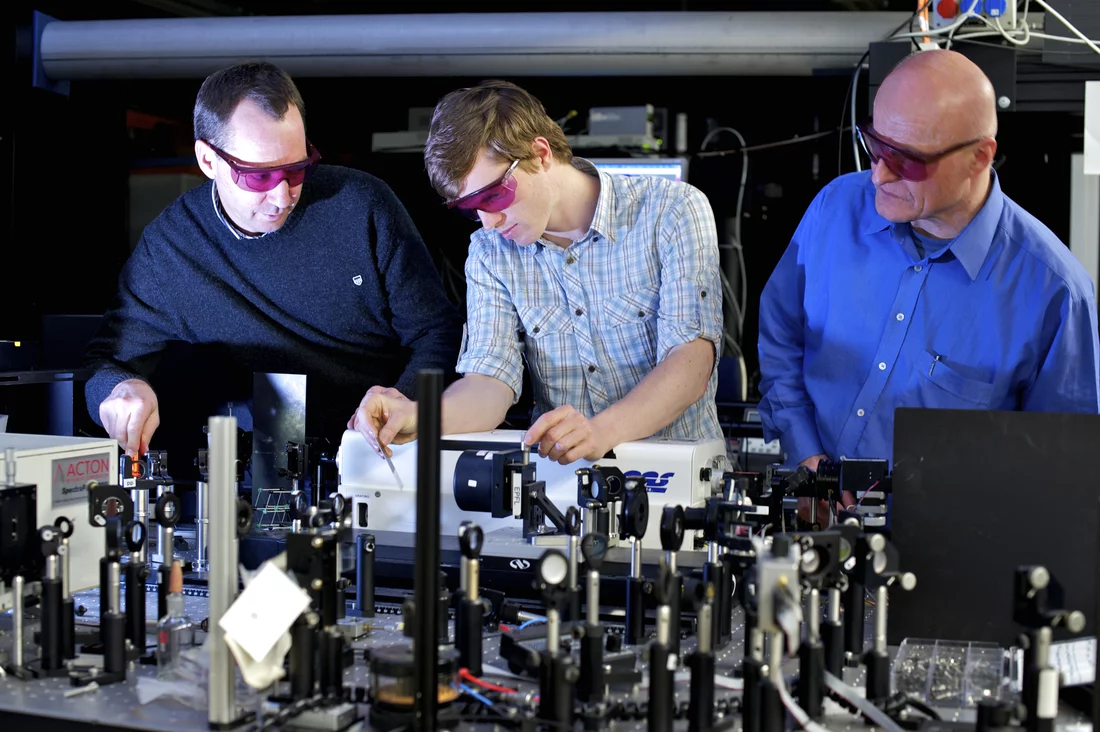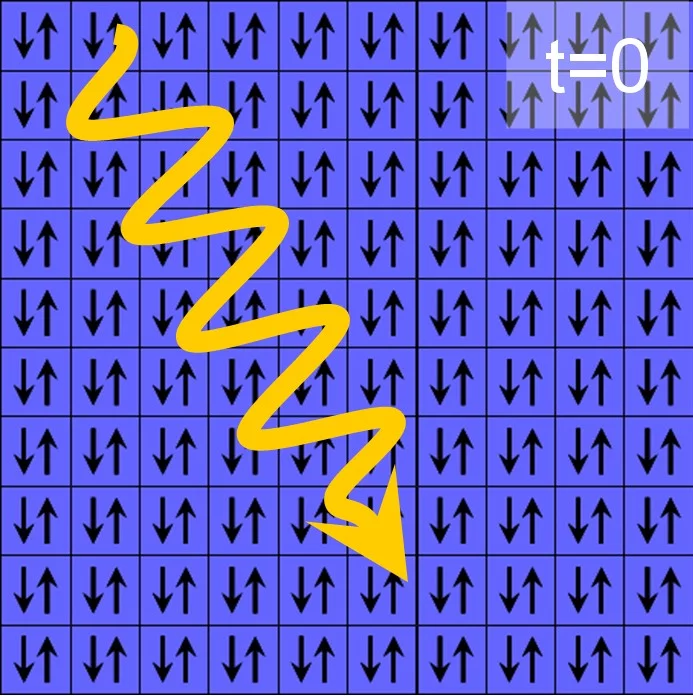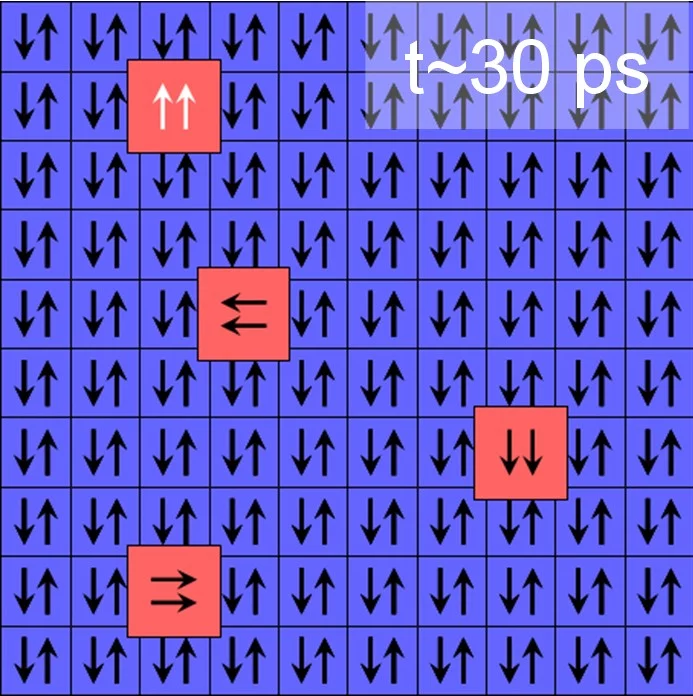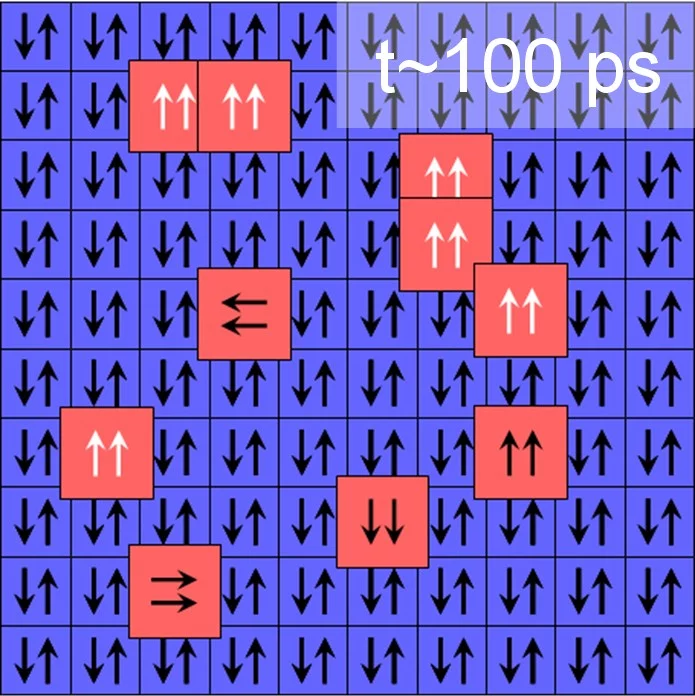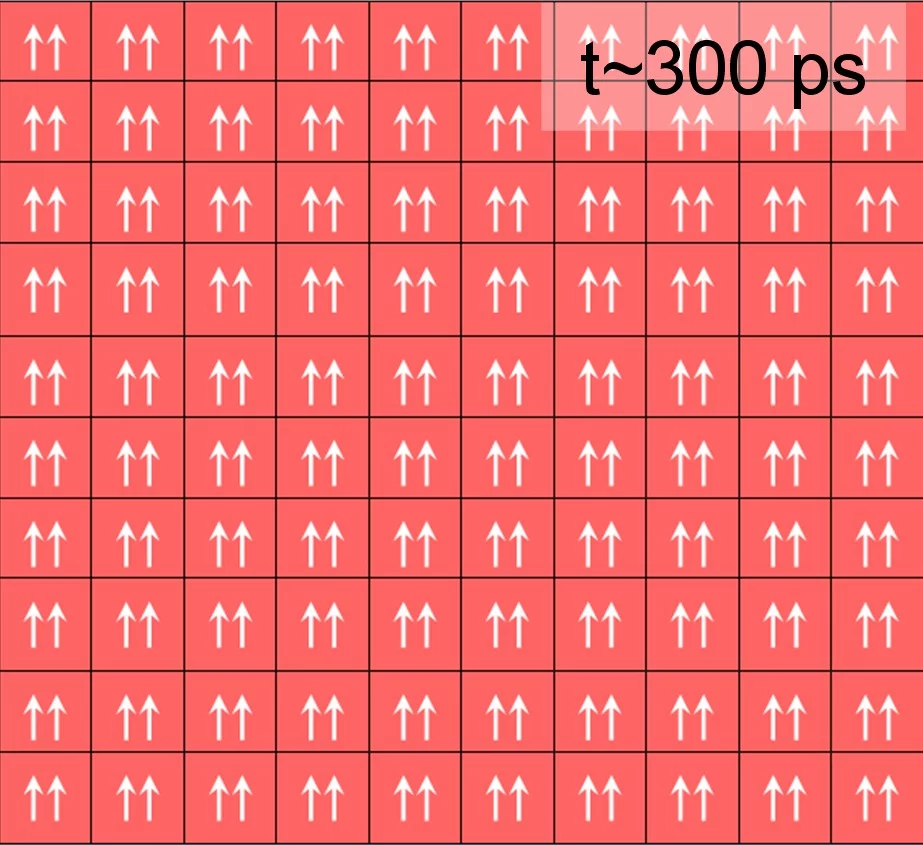Researchers at the Paul Scherrer Institute are finding out how long it takes to establish magnetism and how this happens
Establishing a magnetically ordered phase in the metallic alloy iron-rhodium takes much longer than the reverse process of demagnetization. This fact was established by researchers of the Paul Scherrer Institute (PSI), Switzerland, together with colleagues of an international collaboration. Magnetism is established in a two-step process. Initially, small magnetic regions form, but have random orientation. Subsequently, these regions rotate until they all have a common orientation. This is reported in an article which has recently been published in the renowned journal “Physical Review Letters”. The result comes from basic research, but has relevance for the computer industry, as it shows which processes limit the speed of magnetic data storage and where improvements might be made.
Magnetism is a phenomenon where we experience the fundamental forces of nature directly. Children couple train carriages using magnets, their parents attach notes to the refrigerator door using decorative magnets, and magnets are used in electrically powered cars to transform electrical energy into motion. Scientists have been fascinated by magnetism ever since its discovery by the ancient Greeks, and have subsequently tried to understand and use it. Almost 20 years ago, they found out how long it takes to demagnetise a material. Together with colleagues from Germany and the US, researchers at PSI have now studied the reverse process of turning magnetism ON. They have been able to show that it takes about 0.3 billionths of a second to magnetise the metallic alloy iron-rhodium. For the scientists, this is a relatively long time, since it is about 300 times longer than the reverse process of turning the magnetism OFF. “It is like in real life. Building a house takes much longer than tearing it down”, says Dr. Christoph Quitmann, the researcher at PSI who thought of the experiment five years ago and is now leading it.
Magnetizing in two steps
Researchers not only want to know how long it takes to magnetise a material, but also how this happens through the material. Every iron atom in a material has what is called a spin, which behaves like an atomic compass needle. A material is magnetic if all these atomic compass needles point in the same direction. Then their magnetic forces add up and become measurable. Turning magnetism ON thus implies aligning the spins, which initially point in random directions, in the same direction. The research team has now found out that this process does not happen uniformly from one side of a sample to the other, or from the perimeter to the centre. Instead, it happens in two steps: First, magnetism occurs in many independent regions, called domains (Phase 1). Later (Phase 2), these domains rotate into a common orientation. In Phase 1, during the so-called nucleation stage, the spins of domains point in arbitrary directions, and thus domains with opposite orientations cancel each other out. Reorientation occurs during Phase 2, when all spins are turned to point in a common direction. Now the magnetic forces add up and become measurable. Nucleation happens relatively quickly, but reorientation takes much longer and dominates the duration of the switching process.
Observations using laser beams and X-rays
For their experiments, the team used the Swiss Light Source (SLS), located at PSI. The SLS is, in principle, a very powerful microscope, which allows materials to be investigated on the nano-scale. For investigating magnetism, the researchers illuminate the sample with short pulses of X-rays, which are deflected (“diffracted”) by the periodic arrangement of the atoms. From the amount of deflection, the distance between the atoms can be calculated. Next, the sample is illuminated by a very brief laser pulse, which heats the sample. This heating induces the change to a magnetic state (iron rhodium turns magnetic at 120°C). After a very short time delay, another X-ray pulse again measures the distance between the atoms. This distance is known to be larger in the magnetic state. Using this technique, the researchers observe how long it takes for the atoms to acquire the larger distance corresponding to the magnetic state, and thus they can discover how long it takes to turn the magnetism ON.
An international network
The research team contained ─ Simon Mariager, Gerhard Ingold, and Christoph Quitmann from PSI ─ and colleagues from Germany and the US. Christian Back and his colleagues from the University in Regensburg used the magneto-optical Kerr effect to measure how long it took to establish magnetism over the entire sample. Eric Fullerton and his colleagues from the University of California at San Diego provided the high-quality iron-rhodium samples for the experiment. These consist of a very thin layer of iron and rhodium, just about 500 atoms in thickness. In order for the atoms of both elements to occupy regularly ordered positions, they were evaporated in layers onto a target crystal.
Next-generation magnetic storage
The research partnership with California shows the direction in which such fundamental research at PSI might be industrially applicable. The team at the University of California at San Diego has strong industrial links for the development of the next generation of hard disks. Whenever large amounts of data are stored for a long time, magnetism is used. To increase the storage density and speed up this process, novel materials are needed which can change their magnetic state even faster. Iron-rhodium is one such material under discussion for the next generation of computer disks. “We are investigating which physical processes limit miniaturization and control the rate of magnetic recording”, says Christoph Quitmann. He and his colleagues will investigate more materials in the future trying to push the limits. Starting in 2016, they will have a new tool at their disposal, the SwissFEL, an even more powerful large-scale light source currently at the pre-construction phase at PSI.
About PSI
The Paul Scherrer Institute develops, builds and operates large, complex research facilities, and makes them available to the national and international research community. The Institute's own key research priorities are in the investigation of matter and material, energy and the environment, and human health. PSI is Switzerland's largest research institution, with 1400 members of staff and an annual budget of approximately 300 million CHF.
Contact
Dr. Christoph Quitmann
Labor für Kondensierte Materie, Forschungsbereich Synchrotronstrahlung und Nanotechnologie, Paul Scherrer Institut, 5232 Villigen PSI, Schweiz
Tel: +41 56 310 4560; E-Mail: christoph.quitmann@psi.ch
Original Publication
Structural and Magnetic Dynamics of a Laser Induced Phase Transition in FeRh
S. O. Mariager, F. Pressacco, G. Ingold, A. Caviezel, E. Möhr-Vorobeva, P. Beaud, S. L. Johnson, C. J. Milne, E. Mancini, S. Moyerman, E. E. Fullerton, R. Feidenhans’l, C. H. Back, and C. Quitmann; Phys. Rev. Lett. 108, 087201 (2012), DOI: 10.1103/PhysRevLett.108.087201

